
Skateboarding video content is difficult to typologise, is it B-roll film, Cinema proper, YouTube content, or a Deluezian multimedia nomadic “assemblage”? Given its recent addition to the cultural landscape, and relatively minimal academic treatment thus far, I attempt to analyse skateboarding film in its style, form, and as a system of meaningful signs that reference each other intra-semiologically and through wider extra-semiotic realities (such as the street itself)(De Saussure, 2000; Peirce & Buchler, 1902). Despite skate cinema being, “An almost total blind spot in the eye of film and media studies” (Hebert, 2019, p. 2), there are scholarly references to an “archive of [skate] video footage from the 1960s” (Dinces, 2011), however, skate film developed from a DIY attitude to being a piece of curated media with a “commercial impetus” (D’Orazio, 2020) when, “in the mid-1980s, the skateboard company Powell-Peralta revolutionised skateboarding subculture by using promotional film” (D’Orazio, 2020). “The ‘skate video’ has become… the primary medium with which skateboarders create subcultural capital” (D’Orazio, 2020). What then, do skaters express from this subcultural capital? What philosophies do they espouse and what pragmatic outcomes do they strive toward? Many concepts from Deleuze and Guattari’s metaphor of the nomad, to Barthesian narrative codes, to Deleuze’s theory of the image (as read in Cinema I & Cinema II), to gender theory, politics and biosemiotics, can be applied to understand skating films as “fluid and fragmented sites of ‘postmodern’ identity formation”, as a response to “neoliberal regimes of accumulation” (Dinces, 2011), and as a vessel for Marxist class struggle, and radical sociopolitical commentary particularly on the grounds of control, conflict, and surveillance (McDuie-Ra, 2021; McDuie-Ra & Campbell, 2022).
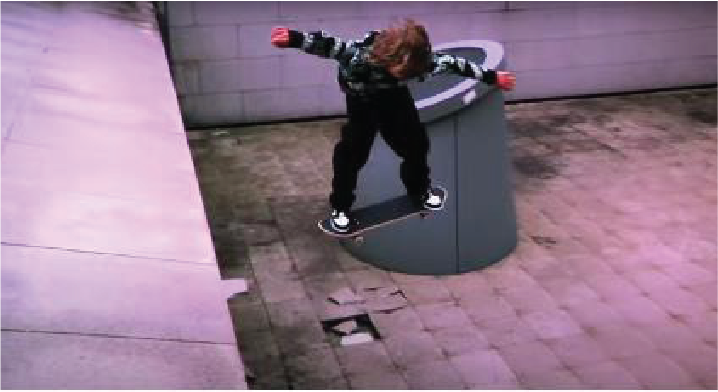
Figure 1, STALLION
Figure 1, as attached above, is a screenshot from New York filmmaker William Strobeck’s 2021 “STALLION” skate film (Strobeck, 2021), which was filmed in Milan, Italy, for the skate company Supreme (who, rather introspectively, plagiarized their colours and typography from Krugman’s 1987 “I Shop Therefore I Am”). In the long shot we can see the point of salience as the floating skater who, “assumes a vortical motion, occupying a smooth space, actually tracing smooth space itself” (Deleuze et al., 1986, p. 35). Figure 1 resonates with Deleuze’s action-image as the screenshot exists within a progression of movement; behavior, but also operates as an affection-image (Deleuze, 2013) as the viewer is invited to imagine this sensation the skater experiences within this suspended space; to sense themselves not stood on a surface, but instead strung between levels as a bead on a parabolic arc of gravity and wind. To the left of the skater we see the angled roof from which he dropped, behind him is the roof’s air vent, and below him are mouldy and somewhat shattered marble tiles, which are abruptly halted by a white brick wall in the frame’s background. If “skate videos have shaped the contours of skateboarding” (D’Orazio, 2020), how have they subverted, deconstructed, reconstructed, reflected, and refracted, the conventions and culture of wider filmmaking? Beyond the skater himself, the other salience of Figure 1 seems to be its pink colour grading which homogenizes the frame through a shared hue. Pink is consciously used here to imbue certain connotations in the viewer, “light shades of most colours such as Pink or Blue are delicate and ethereal.” (Kumar & Joshi, 2007, p. 44), while the gendered notion of colour (LoBue & DeLoache, 2011), and Strobeck’s subversion of this in what is often defined as a “masculine practice” (Beal, 1996), starts to unveil the complicated interplay between skateboarding film and politics. Scholars have posited that skateboarding offers an “alternative masculinity” (Beal, 1996) to “hegemonic masculinity” (Carrigan et al., 2018), however this redefinition of masculinity still “reproduced patriarchal relations” (Beal, 1996), such as gate-keeping from women and queer people within the space. New Zealand specifically has organisations actively making space for ‘pink’ in our skateparks (Chapman, 2023) and scholarly research has started to note the pouvoir (potential) of queer and women’s skateboarding (Bäckström & Nairn, 2018; Geckle & Shaw, 2022; Geckle, 2021). Returning to the connotative semiotics of colour, politically speaking, “Pink tends to signify moderate socialist.” (Kumar & Joshi, 2007, p. 41). The star-figured skater is salient within the “constellation” of signs in Strobeck’s film, he operates by “bordering, encircling, shattering” his environment, much as Strobeck refracts the gender binary back on itself by recontextualising pink around a risk-taking, patriarchal ethos (Atencio et al., 2009; Deleuze et al., 1986, p. 3).
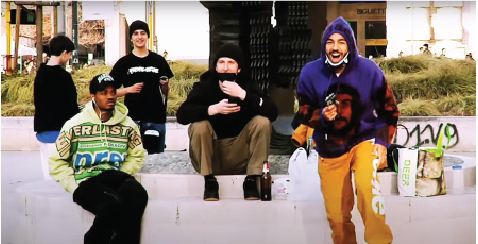
Figure 2, STALLION
The above medium long shot is split vertically as thirds with a skater sat in the foreground of the left third, a skater sat in the midground of the central third, and pro skater, rapper, and model Sage Elsesser stepping forward and laughing over a face mask on the right of the frame (Strobeck, 2021). Elsesser’s father left Chile as a refugee in the US-backed Pinochet Coup when the military seized civilian control (and literally threw communists out of helicopters) in what had until then, been a democratic socialist state (Devine, 2014; Elsesser, 2023). This has particular resonance with his hoodie of Argentine Marxist revolutionary Che Guevara who has achieved a mythic status as an inspirational icon (although technically a culturally learnt symbol as a viewer must be familiar with socialist history) of revolution (Peirce & Buchler, 1902; Prestholdt, 2019; Savić & Milad, 2020). What is pragmatically displayed in the attached frame is the sociology of skaters using a public place, ephemerally territorialising it, “skateboarders reject the idea that the city is only a grand project of planners and magnificent Utopias and suggest, instead, that it is also about local micro-spaces and about actions of actual city residents” (Borden, as cited in Spencer, 2001). As skaters express presence in a city and, “people are territorial animals, always seeking to secure a living space, which they then appropriate, personalise and defend against intruders” (Fineman et al., 2005, pp. 72-84), we can observe through skate film that skaters engage in a fluid “fragmentation of urban space” (Borden, 1999), as they ride through the streets deterritorialising Deleuze’s despotism of the state (Deleuze et al., 1986), and reterritorialising space through “secrecy, speed and affect.” (Carriere, 1985). How then, does this organism operate as it attempts to reclaim urbanism? What structure, if any, does it carry? “I’m not on the side of the family, I side with the pack” (Eugene Sue, as cited by Deleuze et al., 1986, p. 13), this sentiment is shared with many skaters and has been depicted cinematically within skateboarding, see Mid90s (Hill, 2018). “[Buildings] can be designed and constructed with a view to limiting or eliminating violations, by ‘designing away’ opportunities for spontaneous, unpredictable and recalcitrant behaviour.” (Fineman et al., 2005, pp. 72-84), this exercising of public control and surveillance demonises the skater who innately disregards, disrupts and violates the prescribed striation and flow of shared spaces as they “ignore the intended use of buildings” (Spencer, 2001). Skateboarding offers a solution to the individualistic culture of the West (Grossmann & Santos, 2020), it’s subsequent social atomisation (Cui, 2024) and the overconsumption, waste, and social degradation (Bartolini & Bonatti, 2002) of late-stage capitalism, by proposing a shift from atomised, isolated, and polluting cars, to packs of wheel-spinning, wind-facing, skateboarders. William Strobeck builds from his depiction of the pack nature of skateboarding’s sociology to the Marxist iconology of Chilean skater Elsesser’s Guevara hoodie and semiotics of accelerationism (Williams & Srnicek, 2013), particularly around the political philosophy’s main idea of radically destabilising/disrupting the state, in this case, the state’s public rules.
Figure 3 communicates the oppressive signified of a fence, and atop this is sat a monochromatic image of a young child wearing a blindfold. This blindfold (as the signified lack of information is implied by the signifier) represents the Orwellian control of information such as propaganda, surveillance, disinformation, denial of truth, and manipulation of the past (Orwell, 1984), as has been seen both in history and current Barthesian mythologies such as the general nihilistic irony of postmodernism and rising political disillusionment (Maher et al., 2018; Slocombe, 2003). Skate stoppers have been noted as an almost passive form of surveillance (McDuie-Ra & Campbell, 2022), while the Turkish state still denies the Armenian genocide (Akçam, 2008; Mamigonian, 2015; Smith et al., 1995), and Russian state media RT recently spent $10,000,000 paying Western influencers to espouse disinformation and pro-Russian propaganda (Stefan Becket, 2024) in an act of “Covert Influence Operations” (Elswah & Howard, 2020; Pandeer, 2024). EC Melodi convey their experience of New York’s urbanism as one of Focault’s Panopticon, where skate stoppers can be seen as one of the Panopticon’s “neutral devices” (Fineman et al., 2005, p. 78) through which the public is watched, disciplined, and punished (Foucault, 2023). EC’s blindfold acts as a referential code towards Orwell and Focault’s literature, while simultaneously and polysemically acting as an enigma code asking, ‘How is society controlled?’ (Barthes, 1980; Bréal, 1887).
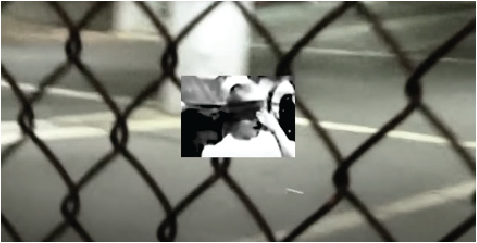
Figure 3, “EC” – EAST COAST SKATE MONTAGE
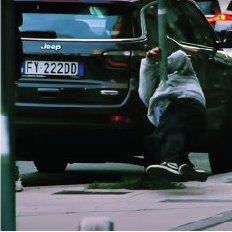
Figure 4, STALLION
Strobeck has captured the psychology and behaviourism of skateboarding film in the above frame where a skater who miscalculated his path, perhaps lost balance, is thrust chest first into a street post, wrapping his limbs around the pole and then slamming into the concrete (Strobeck, 2021). To Barthes, this would be a proairetic (or action) code as the sign belongs to patterns of behaviour that constitute a narrative (Barthes, 1980). This pattern of behaviour is all too familiar to skaters; trial and error; getting hurt, adjusting your body to stop that error from occurring, and repeating until you ‘land’ the trick and ‘roll away’. This, “Association between a particular behaviour and a consequence” (Skinner, 2019), links to Skinner’s operant conditioning where the voluntary behaviour is skating, ‘eating concrete’ is positive punishment, and the euphoria of rolling away is reinforcement. To a skater, the street itself exists as a Skinner box, and “building elements like ledges and window sills” (Borden, 1999) dwell ‘in potentia’ flaunting their geometry, form, angles, and materiality towards “skate rats” (Hebert, 2019). The nature of skateboarding from punishment to reinforcement, with punishment resulting from engaging with one’s environment and reinforcement instilling a sense of pride and celebration in the skater and his ‘pack’, oscillates back to the primitive hunt. Skateboarders have been described as “Umweltin”(Hebert, 2019), referencing Uexküll’s field of biosemiotics or “how animals perceived their environments” (Bailey, 2018). As skate film “accentuates a hyper-focus on movement and rhythm” (Hebert, 2019, p. 3) while the skater themselves is engrossed in their sensory perception, it can be said that skate film as a “medium is still haunted by the animal figure, chasing the ever-escaping metaphor” (Lippit, 2000, as cited in Hebert, 2019, p. 2). Through viewing skate film intra-semiologically (by observing skate film as a documentary of a skater processing a closed system of sensory experience) its inherent, behavioural meanings become apparent and we uncover how skateboarding leverages the same operant conditioning that caught our ancestor’s dinner, and skate film can thus be seen from a naturalist perspective.
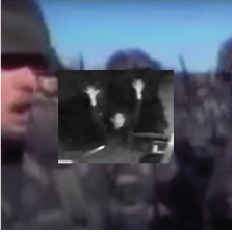
Figure 5, “EC” – EAST COAST SKATE MONTAGE
The side screenshot can be found in EC’s intro montage alongside Figure 3 (Melodi, 2019) and orient the viewer on the political position of radical avant-garde New York skaters around themes of conflict and war. Figure 5 can be read as how Hegel’s dialectic would view generational philosophy, where the background frame of armed soldiers represents the post-World War II thesis of foreign intervention such as Germany’s partition, the bombing of Japan, or the policing of global trade routes by the US Navy, the inset frame contradicts this militarism with a contrasting image of surrender; helplessness; which conveys the pacifism of the 60s and the anti-Vietnam war movement, while the final frame (the image as a whole) alludes to the postmodern synthesis of this conflict (militarism/pacifism), such as Gen Z views that defending Ukraine is necessary but Israeli bombing of Gaza is unethical (Buheji et al.; Fasching, 1993; GRAD & LUŢAI, 2022; Harrison, 1993; Hegel et al., 1869; Kant, 1908). Through frame within a frame (and the dialectic of the resultant frame synthesising the antithesis of the previous two), EC Melodi use skate film to convey complex political views on conflict and realises a postmodern conclusion.
“This looks like reality, but it cannot be reality because it is so visually discontinuous, therefore, it must be a dream” (Murch, 2001, p. 58), Editor Walter Murch discusses the psychological effect of the cut on an audience. If films are a dream, skate films are a fever dream, where film techniques (colour grading, salience, long shot, medium long shot, rule of thirds, mise en scene, frame within a frame) and semiotic motifs (iconology, Deleuze’s movement-image, Sassuerean difference, Peircean connotation, Barthesian codes, even Hegel’s dialectic) are scavenged almost schizophrenically, to form an entirely new lattice of meaning that attempts to understand gender, sociology, societal power dynamics and class struggle, the interaction between human perception and animal perception, the moral dilemma of war, and information politics, all to “trace creative lines of escape” (Deleuze et al., 1986).